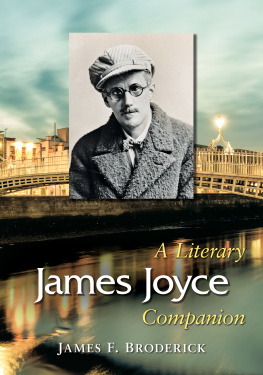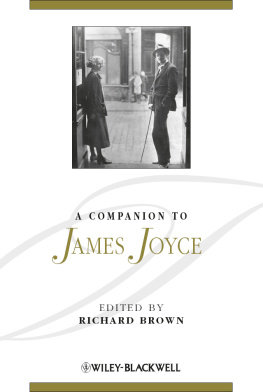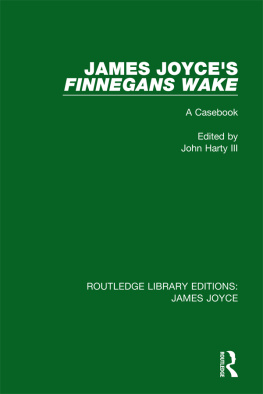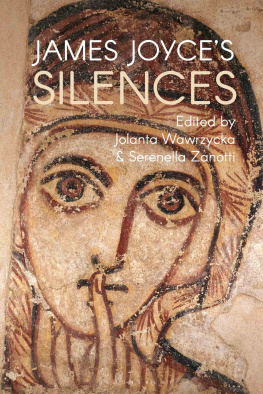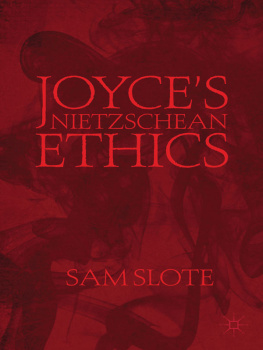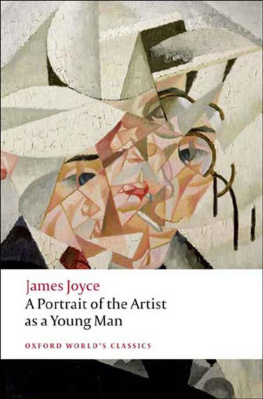
MCFARLAND LITERARY COMPANIONS
BY MARY ELLEN SNODGRASS
1. August Wilson (2004)
2. Barbara Kingsolver (2004)
3. Amy Tan (2004)
4. Walter Dean Myers (2006)
5.Kaye Gibbons (2007)
6.Jamaica Kincaid (2008)
8.Peter Carey (2010)
10.Leslie Marmon Silko (2011)
13.Isabel Allende (2012)
15.Brian Friel (2017)
BY PHYLLIS T. DIRCKS
7.Edward Albee (2010)
BY ERIK HAGE
9.Cormac McCarthy (2010)
BY ROCKY WOOD
11.Stephen King (2011)
BY TOM HENTHORNE
12.William Gibson (2011)
BY MARK CONNELLY
14.Saul Bellow (2016)
BY LAURENCE W. MAZZENO
16.James Lee Burke (2017)
BY JAMES F. BRODERICK
17.James Joyce (2018)
James Joyce
A Literary Companion
JAMES F. BRODERICK
McFarland Literary Companions, 17

McFarland & Company, Inc., Publishers
Jefferson, North Carolina
Also by JAMES F. BRODERICK
AND FROM MCFARLAND
Now a Terrifying Motion Picture! Twenty-Five Classic Works of Horror Adapted from Book to Film (2012)
The Literary Galaxy of Star Trek: An Analysis of References and Themes in the Television Series and Films (2006)
LIBRARY OF CONGRESS CATALOGUING DATA ARE AVAILABLE
BRITISH LIBRARY CATALOGUING DATA ARE AVAILABLE
e-ISBN: 978-1-4766-3166-0
2018 James F. Broderick. All rights reserved
No part of this book may be reproduced or transmitted in any form or by any means, electronic or mechanical, including photocopying or recording, or by any information storage and retrieval system, without permission in writing from the publisher.
Front cover: inset James Joyce (Poetry Collection of the University Libraries, State University of New York at Buffalo); background Happenny Bridge in Dublin 2018 iStock/Massimo Fusaro
McFarland & Company, Inc., Publishers
Box 611, Jefferson, North Carolina 28640
www.mcfarlandpub.com
Acknowledgments
To weigh in with an assessment of a writer of James Joyces importance and critical legacy requires a willful forgetfulness. If I were truly mindful of the hundreds of scholars who have dedicated their lives to Joyce and his works, the prospect of elbowing my way forward to deliver my own critical take on Joyce might simply seem too overwhelming. But a couple thoughts sustain me: (1) Joyces work champions the individual seeking to make his or her own voice heard in the crowd. His heart was with those who know their tasks are daunting but who try anyway. Thats what Joyce himself did, so Im taking a cue here from him. (2) We are all first-time readers of Joyce. No matter how many pages of his work youve dog-eared or annotated, youll always find something new, so a fresh voice neednt fear squelching.
This book took a little over a year to write but it was decades in the making. It began (although I certainly did not know it then) during a rainy spring afternoon in 1992 when I met Professor Martha Black at her Brooklyn home to share a cup of tea and talk about a study abroad program she was leading to Ireland later that summer. That trip set everything in motion, and that motion eventually swept me into the orbit of Professor Edmund Epstein of the Graduate Center of the City University of New York. Martha Black and Eddie Epstein represented the best of the intellectual tradition: they were broad-minded, passionate about their interests, exacting in their standards and truly generous spirits. Im fortunate to have worked closely with these eminent Joyce scholars.
Great thanks to the staffs of the Montclair, New Jersey, Public Library, the Glen Ridge, New Jersey, Public Library, the New Jersey City University Guarini Library, and the Poetry Collection of the University Libraries, University at Buffalo, the State University of New York for assistance in locating materials. Sean Latham, editor of the James Joyce Quarterly, was gracious and thoughtful in my interview with himqualities not at all atypical in the Joyce community.
My daughters Maddy and Olivia provide much more to me than I can enumerate here. Their artistic passion and intellectual fervor inspire me every day, and its not really fair that they are already so much smarter than me.
Finally, theres Miri, who ignites each day with Joycean splendor. Although your bookshelves are already over-stuffed, heres one more from your secret admirer.
Preface
James Joyce was a singular writerfor many reasons. His claim on the imagination and intellect of a centurys worth of readers and scholars is readily demonstrated by the worldwide legion of enthusiasts who read his books and, in many cases, immerse themselves in societies of fellow Joyceans to share insights and activities, from barroom discussion of his work to trans-oceanic excursions to meet the writer on his home turf. Such zeal can be baffling, if not downright off-putting, to readers who have little or no knowledge of Joyces work. This book, James Joyce: A Literary Companion, aims to provide something of value to everyone interested in Joyceno matter the degree of familiarityoffering an overview of Joyces life and works helpful to those encountering Joyce for the first time as well as information and interpretations for those readers more conversant with this enigmatic Irishman.
Compared to many other writers whose works have inspired worldwide admiration (from Shakespeare to Stephen King), Joyce didnt write many books. His reputation rests on four major works of fictiona collection of short stories and three novels. Yet these worksand a few excursions into poetry, drama, and non-fictionhave sustained a zealous readership that finds in them a depth of insight and experienceand complexitythat is unmatched in imaginative literature. Its the complexity perhaps that many readers think of first when they think of Joyce. But as this book seeks to demonstrate, Joyces complexity is no more (or less) than the complexity of life. If you can survive a day in the modern world, you can certainly survive reading Joyce.
After a comprehensive chronology introducing readers to the timeline of Joyces life and work, this volume offers a section-by-section guide to each of the major works: Dubliners, A Portrait of the Artist as a Young Man, Ulysses, and Finnegans Wake. For each of these works, there is a comprehensive introduction that offers a critical overview of the work, its origins, development, publication history, critical reception, and legacy. For Dubliners, a story-by-story guide reveals the major characters, plot points, and themes as well as any biographical connections to Joyces life at the time of composition. For each of the novels, this book provides a chapter-by-chapter discussion of all the important aspects of the work. Its not uncommon for first-time readers of Ulysses or Finnegans Wake to rely on secondary sources to help them puzzle out the text. It is hoped that James Joyce: A Literary Companion will serve that function for interested readers.
The next section of the book, AZ Literary Companion, addresses the people, places, events, and ideas that impacted Joyces life, or that were impacted by his work. There is a lengthy section on his only play, Exiles, an extended discussion of his poetry as well as his odd, intoxicating prose poem Giacomo Joyce
Next page
